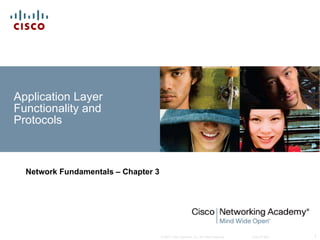Exploration network chapter3
- 1. Application Layer Functionality and Protocols Network Fundamentals – Chapter 3
- 2. Objectives Define the application layer as the source and destination of data for communication across networks. Explain the role of protocols in supporting communication between server and client processes. Describe the features, operation, and use of well-known TCP/IP application layer services (HTTP, DNS, SMTP).
- 3. Applications – The Interface Between Human and Data Networks Explain that applications provide the means for generating and receiving data that can be transported on the network
- 4. Applications – The Interface Between Human and Data Networks Explain the role of applications, services and protocols in converting communication to data that can be transferred across the data network
- 5. Applications – The Interface Between Human and Data Networks Define the separate roles applications, services and protocols play in transporting data through networks
- 6. Applications – The Interface Between Human and Data Networks Describe the role protocols play in networking and be able to identify several message properties that can be defined by a protocol
- 7. The Role of Protocols in Supporting Communication Describe the roles of client and server processes in data networks
- 8. The Role of Protocols in Supporting Communication List common Application Layers services and protocols
- 9. The Role of Protocols in Supporting Communication Compare and contrast client server networking with peer-to-peer networking and peer-to-peer applications
- 10. Features, Operation, and Use of TCP/IP Application Layer Services Describe the features of the DNS protocol and how this protocol supports DNS services
- 11. Features, Operation, and Use of TCP/IP Application Layer Services Describe the features of the HTTP protocol and how this protocol supports the delivery of web pages to the client
- 12. Features, Operation, and Use of TCP/IP Application Layer Services Describe the features of the POP and SMTP protocols, and how these protocols support e-mail services
- 13. Features, Operation, and Use of TCP/IP Application Layer Services Describe the features of the Telnet protocol and identify several of its uses in examining and managing networks
- 14. Features, Operation, and Use of TCP/IP Application Layer Services Describe the features of the SMB protocol and the role it plays in supporting file sharing in Microsoft-based networks
- 15. Features, Operation, and Use of TCP/IP Application Layer Services Describe the features of the Gnutella protocol and the role it plays in supporting P2P services
- 16. Summary
- 17. Ěý

















